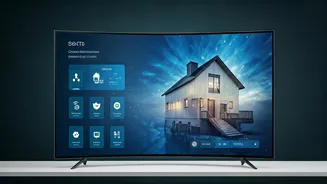Soundbar Essentials
Soundbars have emerged as a cornerstone of modern home entertainment, offering a streamlined path to superior audio quality. Unlike complex surround sound
setups, soundbars integrate multiple speakers into a single, compact unit that easily fits beneath your television. The appeal lies in their simplicity, ease of installation, and ability to drastically improve the audio clarity and depth of your viewing experience. They offer a significant upgrade over the often-underwhelming built-in speakers of modern televisions. When contemplating a soundbar, consider the size of your room, your budget, and the features that best align with your entertainment preferences. Features like virtual surround sound, multiple connectivity options (HDMI, Bluetooth), and the inclusion of a separate subwoofer can dramatically impact the performance and immersion you achieve. The right soundbar can deliver everything from crisp dialogue in your favorite shows to powerful bass that adds extra oomph to action-packed movies and games. Evaluating these factors ensures your investment delivers the best possible audio enhancement.
Key Features Explored
Understanding the core features of a soundbar is crucial to selecting the one that best suits your requirements. HDMI ARC/eARC is an essential feature, allowing you to connect your soundbar to your TV with a single cable, simplifying setup and enabling the transmission of high-quality audio formats like Dolby Atmos and DTS:X. Bluetooth connectivity provides flexibility, allowing you to stream music directly from your smartphone or tablet. The presence of a subwoofer is another key consideration, as it handles the low-frequency sounds, delivering deep, impactful bass. Subwoofers can be either integrated or separate, with separate subwoofers offering more placement flexibility. Consider the number of channels supported by the soundbar; a 2.1-channel system typically features two front-facing speakers and a subwoofer, while higher channel counts (5.1, 7.1) add surround speakers, offering a more immersive experience. Virtual surround sound technology simulates the effect of surround speakers using advanced processing, creating a wider soundstage. Additionally, think about the sound modes available, such as movie, music, and voice modes, which optimize audio settings for different content types.
Placement and Setup
Proper placement and setup are critical to maximizing the performance of your soundbar. Position the soundbar directly in front of your television, ideally below the screen and centered. Ensure the soundbar isn’t blocked by any objects that could obstruct the sound. If you have a separate subwoofer, position it on the floor, ideally near a wall or corner, to enhance the bass response. The distance between the soundbar and the listening position is also important; aim for a distance that complements the size of your room. When connecting your soundbar, HDMI ARC/eARC is generally the preferred option, as it supports the highest quality audio formats and simplifies the connection process. If your TV does not support HDMI ARC/eARC, you can use an optical cable. Follow the manufacturer's instructions for setting up the soundbar’s audio settings to optimize the sound for your specific room and preferences. Most soundbars come with an auto-calibration feature that analyzes the acoustics of your room and automatically adjusts the audio settings for optimal performance. This process ensures the soundbar is perfectly tuned for your listening environment.
Connectivity Options
The connectivity options of a soundbar greatly influence its versatility. HDMI ARC (Audio Return Channel) or eARC (Enhanced Audio Return Channel) are essential for modern soundbars, as they allow you to transmit high-quality audio from your TV back to the soundbar with a single cable. eARC supports higher bandwidth and advanced audio formats like Dolby Atmos and DTS:X, enhancing the immersive audio experience. Bluetooth connectivity is another common feature, enabling you to wirelessly stream music from your smartphone, tablet, or other Bluetooth-enabled devices. Optical digital audio inputs are still commonly found on soundbars and can be used to connect older TVs or devices that don’t support HDMI ARC/eARC. Some soundbars also include USB ports for playing music files from flash drives or other storage devices. Wi-Fi connectivity allows for streaming music through services like Spotify, Pandora, or Apple Music, as well as accessing firmware updates. Considering your device compatibility needs and the audio quality you desire, choose a soundbar with the appropriate connectivity options to ensure you can easily integrate it into your home entertainment system.
Subwoofer Considerations
A subwoofer significantly enhances the bass response and overall audio experience of a soundbar system. Subwoofers come in two primary types: integrated and separate. Integrated subwoofers are built into the soundbar itself, providing a more compact design but potentially less powerful bass. Separate subwoofers, on the other hand, are typically wireless and placed on the floor, offering a deeper and more impactful bass experience. Separate subwoofers also provide greater flexibility in placement, allowing you to position them to optimize the bass response within your room. Consider the size of your room and your listening preferences when choosing a subwoofer. Larger rooms require more powerful subwoofers to produce the desired bass effect. The wireless connectivity of a subwoofer adds convenience to the setup. Additionally, make sure to consider features such as the subwoofer's frequency response and power output (measured in watts) to ensure it complements your soundbar and delivers the bass impact you desire. The right subwoofer can transform your home theater experience, adding depth and richness to movies, music, and games.






